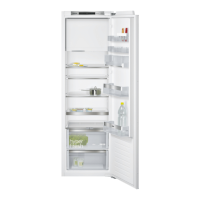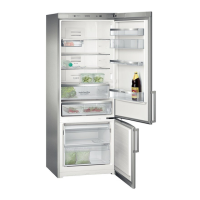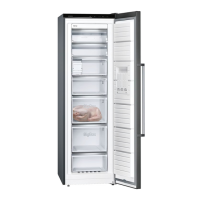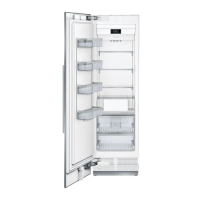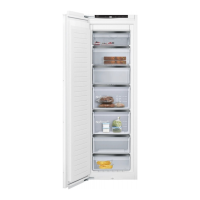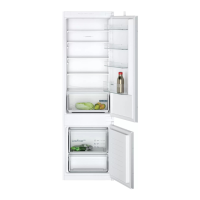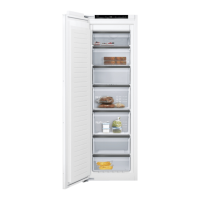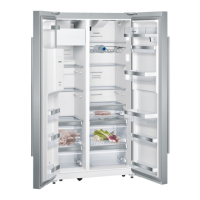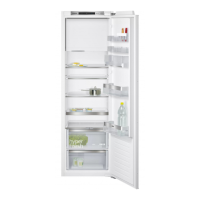
Do you have a question about the Siemens iQ500 KI82L Series and is the answer not in the manual?
Read manual carefully, keep it safe for future reference, and do not connect if damaged in transit.
Appliance is for chilling/freezing food and ice cubes in private households and domestic environments.
May be used by children aged 8+ or people with reduced abilities if supervised and instructed.
WARNING: Risk of injury. Do not lift the appliance alone due to its high weight.
WARNING: Risk of electric shock and explosion. Ensure proper grounding, ventilation, and no extension cords.
WARNING: Risks of electric shock, suffocation, explosion, fire. Use in enclosed spaces, avoid heat/humidity, keep packaging away.
WARNING: Risk of electric shock/fire. Never operate a damaged appliance or cord. Contact service for repairs.
Packaging materials are environmentally compatible and recyclable. Sort and dispose of components separately.
Install away from heat sources, keep doors closed briefly, use cool bags for transport, and cool food before storing.
Check all parts after unpacking for transport damage and completeness. Contact dealer for any complaints.
Ensure adequate ventilation space, stable subfloor, and respect permitted room temperatures and niche dimensions.
Install the appliance according to the enclosed installation instructions.
Remove informative material, protective foil, and transit bolts. Clean the appliance thoroughly before first use.
Insert the mains plug into a nearby socket and check it is properly inserted. The appliance is now ready.
Provides an overview of the appliance parts, including freezer and refrigerator compartments and the control panel.
Details the functions of the control panel buttons for setting temperature, alarms, and operating modes.
Shelves can be removed and re-inserted elsewhere to adjust storage space as required.
Use the variable shelf for tall items. Its front section can be removed and slid under the rear part.
Pull out the extendable shelf for improved overview and quicker access to food items.
The freezer compartment shelf can be removed for flexibility. Reinstall support rails and glass plate.
Store fresh produce in this container. Adjust humidity to optimal levels for different foods and fill levels.
A dedicated compartment for storing butter and hard cheese.
Door racks can be adjusted by removing and re-inserting them in different positions.
Utilize original accessories like can holders, egg trays, and bottle holders for specific storage needs.
Press the power button. The appliance begins cooling. Set the required temperature thereafter.
Wait for temperature stabilization before adding food. Allow vacuum to equalize after closing door.
Press the power button to turn the appliance off.
Adjust refrigerator temperature using +/- buttons. Freezer temperature is influenced by refrigerator settings.
Cools compartments more intensively. Activate 4-6 hours before adding large quantities of food.
Activates if the door is left open for too long. Silence by closing door or pressing alarm button.
Store food covered, avoid placing items against the back wall, and cool hot food before storing.
Understand the coldest and warmest zones for optimal storage of perishables and less sensitive items.
Check if the refrigerator has reached a safe temperature range (4°C or colder). Adjust temperature if needed.
Always keep the freezer door securely closed to prevent thawing and ice build-up.
Indicates how much food can be frozen. Use Super function and store food at the back for faster freezing.
Store food in airtight packaging. Avoid contact between new and frozen food. Spread food out for quicker freezing.
Freeze fresh, undamaged food in portions. Blanch vegetables and prepare fruit. Avoid unsuitable items.
Provides recommended storage times for various foods like fish, poultry, and vegetables at -18°C.
CAUTION: Do not refreeze defrosted food. Defrost items in the refrigerator or at room temperature.
Condensation and frost on the back panel defrost automatically. Ensure the drainage channel remains clear.
The freezer compartment does not defrost automatically. Regular defrosting is required to maintain efficiency.
Switch off, disconnect power, remove food, and then remove fittings and shelves for cleaning.
WARNING: Risk of electric shock. Use soft cloths and mild detergent. Avoid steam cleaners or harsh abrasives.
Regularly clean the channel and hole to ensure proper condensation drainage, e.g., with a cotton bud.
Remove shelves and extendable shelves for thorough cleaning, following specific removal instructions.
Remove specific components like freezer shelves, fruit containers, and door racks for deep cleaning.
Check for showroom mode or perform self-test. Contact customer service if issues persist.
If the LED lighting does not function, contact customer service for assistance.
Indicates an electronic fault. Try switching off/on, disconnecting/reconnecting. Contact service if error persists.
If temperature is too warm or cold, check settings and allow stabilization time. Recheck later.
The condensation channel or drainage hole may be blocked. Clean them to resolve the issue.
Normal operating noises from motor, fan, or refrigerant. Also check for touching bottles or containers.
Switch off, disconnect power, remove food, defrost, and clean. Leave door open for ventilation.
Dispose of old appliances environmentally. Ensure children cannot access them to prevent risks.
Locate product and production numbers on the rating plate. Keep these details for service inquiries.
